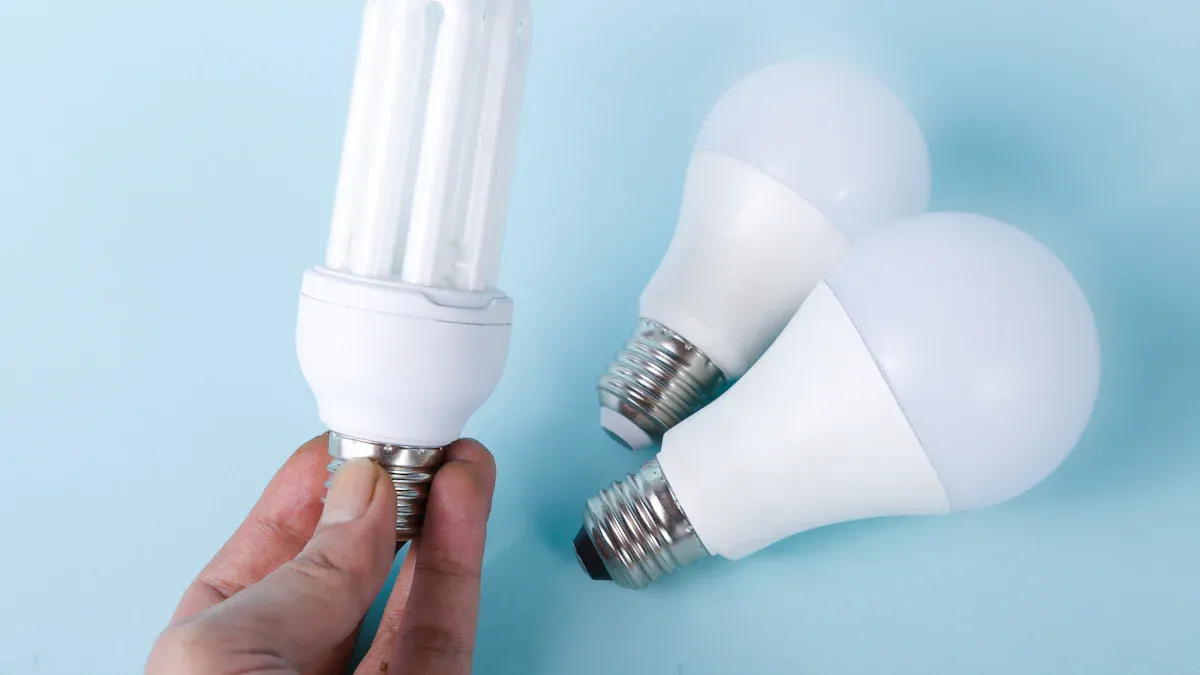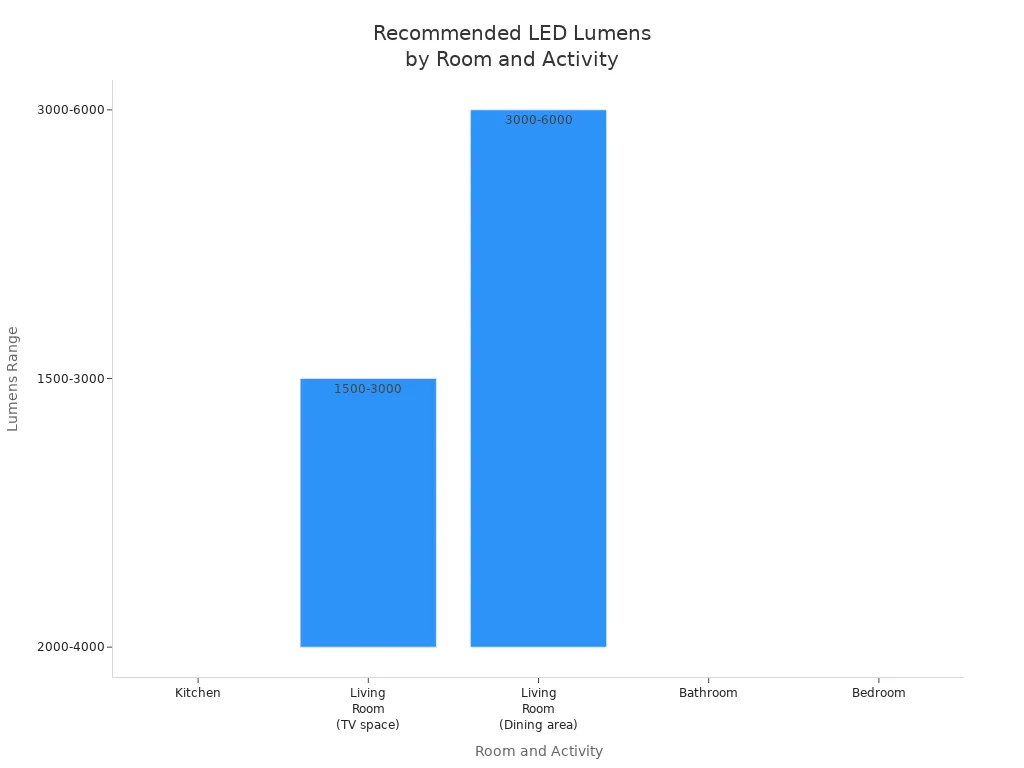White LED Bulbs: Types, Benefits, and Selection Tips

White LED bulbs are changing the way you light your Home. These bulbs use advanced Led Light technology to offer bright, energy-saving light in every room. More people are making the switch—just look at the chart below.
You might notice how color temperature in white led bulbs shapes the mood in your space. As more bulbs appear in homes and businesses, you can choose the Product that fits your needs best. Think about how your lighting makes you feel and what you want to improve. About Us pages often highlight this shift, but your own choices matter most.
Key Takeaways
White LED bulbs use less power than old bulbs. They save energy and money. They also last for many years. - Pick the right color temperature for your room. Warm light is good for relaxing places. Cool light works well in work areas. - Make sure the bulb shape and base fit your fixture. This helps the bulb work safely and fit right. - Dimmable and smart LED bulbs let you change the light. You can adjust brightness and color for any activity. - Look for labels like ENERGY STAR on the box. These labels mean the LED bulbs are safe, efficient, and last a long time.
What Are White LED Bulbs?
How LED Bulbs Work
You might wonder how led bulbs actually make light. When you turn on a led light bulb, electricity flows through a tiny semiconductor inside. This movement of electrons across the p-n junction creates energy. That energy turns into photons, which is just a fancy word for light. This process is called electroluminescence. To get white light, manufacturers often use a special coating called phosphor or mix different colored leds together. The result is a bright, steady glow that turns on instantly—no waiting for a warm-up like with some older bulbs.
Let’s look at how led bulbs compare to traditional options:
Led bulbs use solid-state technology, so they waste less energy as heat.
Incandescent bulbs rely on a glowing wire, which gets very hot and uses more power.
CFL bulbs need a gas and a coating, which means they take time to reach full brightness.
Led light bulbs work well in cold places and last much longer than other types.
Key Features of LED
Led bulbs stand out for many reasons. Here’s a quick table to show you the main differences:
Aspect | LED Bulbs | Incandescent Bulbs |
|---|---|---|
Energy Efficiency | High; saves electricity | Low; uses more energy |
Lifespan | Up to 25,000 hours or more | About 1,000 hours |
Heat Emission | Low; stays cool | High; gets very hot |
Cost | Higher at first, saves over time | Cheaper, but needs replacing |
Light Quality | Many color choices | Mostly warm light |
Safety | No hazardous materials | Higher fire risk |
You get instant light with led bulbs, and you don’t have to worry about them breaking easily. Led lamps also work well in smart homes and can change color or dim to fit your mood. Because led light bulbs use less energy and last longer, you save money and help the environment. Plus, white led bulbs now offer a wide range of color temperatures, so you can pick the perfect light for any room.
Tip: Led lamps are safer for kids’ rooms because they stay cool and don’t break as easily as glass bulbs.
Types of White LED Bulbs

When you shop for white led bulbs, you will see many choices. Each type gives you different lighting effects and fits different fixtures. Let’s break down what you need to know.
Color Temperature Options
Color temperature tells you how warm or cool the light feels. You measure it in Kelvin (K). Lower numbers mean a warmer, yellowish light. Higher numbers give you a cooler, bluish light. Here’s a quick look at the main ranges:

Color Temperature (K) | Description | Best For |
|---|---|---|
1800K - 2700K | Warm Glow | Bedrooms, living rooms |
3000K - 3500K | Neutral Bright | Kitchens, bathrooms, offices |
4000K | Cool White | Classrooms, workspaces |
5000K - 6500K | Daylight | Garages, retail, outdoor areas |
You might want warm white for a cozy feel in your bedroom. Neutral or cool white works well in kitchens or offices. Daylight bulbs help you see clearly in garages or when you need to focus.
Tip: Try tunable led bulbs if you want to change the color temperature for different times of day or activities.
Bulb Shapes
Led bulbs come in many shapes. Each shape fits a different fixture or purpose. Here are some common ones:
A19: The classic round bulb for most lamps and ceiling lights.
Candle (B10, C7): Slim and pointed, perfect for chandeliers or wall sconces.
Reflector (BR30, BR40): Wide and flat, great for recessed lighting or spotlights.
PAR (PAR20, PAR38): Used for outdoor floodlights or track lighting.
MR16: Small and focused, often found in accent or display lighting.
Globe: Large and round, ideal for bathroom vanities.
Each shape helps you get the right look and light spread for your space.
Base Types
The base is the part of the led light bulb that screws or plugs into the socket. You need to match the base to your fixture. Here are the most common types:
Base Type | Where You’ll Find It |
|---|---|
E26 (Medium) | Most lamps and ceiling fixtures |
E12 (Candelabra) | Chandeliers, night lights |
GU10 | Track and recessed lighting |
GU5.3 | Low-voltage fixtures, accent lighting |
G53 | Specialty and commercial fixtures |
If you want more control, look for tunable or multicolor led bulbs. These let you adjust the color and brightness to fit your mood or activity. Some led lamps even connect to smart home systems, so you can change your lighting with your phone or voice.
Led light bulbs now offer more choices than ever. You can pick the perfect bulb for every room and every need.
Benefits of LED Bulbs
Energy Efficiency
You probably want to save money on your electric bill. With led bulbs, you can do just that. These bulbs use much less power than old incandescent or CFL bulbs. For example, a 60-watt incandescent bulb can be replaced by a 7-watt led bulb. That means you save about 53 watts every time you turn on the light. Over 25,000 hours, an incandescent bulb costs about $169 in electricity, while an led bulb costs only $30. That’s a huge difference!
You get up to 80% energy savings with led bulbs. This energy savings potential makes led bulbs the top choice for energy-efficient lighting. You also help the planet by using less power.
Longevity
You don’t want to change bulbs all the time. Led bulbs last much longer than other types. A single led bulb can shine for about 25,000 hours. That’s years of light! In fact, one 12W led bulb can last as long as 25 incandescent bulbs or 2.5 CFL bulbs. Here’s a quick look:
Bulb Type | Average Lifespan (Hours) |
|---|---|
Incandescent | 1,000 - 1,500 |
CFL | 8,000 - 12,000 |
LED | 40,000 - 50,000 |
With long-lasting led bulbs, you spend less time and money on replacements. You also enjoy more cost savings over time.
Environmental Impact
Choosing led bulbs is good for the environment. These bulbs use up to 90% less energy than incandescent bulbs. They also last up to 25 times longer. Led bulbs do not contain mercury, so you don’t have to worry about toxic materials. About 95% of an led bulb can be recycled. This makes them a smart pick for eco-friendly, high-efficiency light bulbs.
Note: Led bulbs lower carbon emissions and reduce landfill waste, making them a greener choice for everyone.
Safety and Comfort
Led bulbs keep you and your family safe. They don’t get hot like old bulbs, so you won’t burn your fingers. Led bulbs do not have fragile glass or filaments, so they break less often. You also avoid UV rays, which can harm your skin and eyes.
For comfort, you can pick warm white led bulbs for a cozy feel or daylight bulbs for bright, clear light. Dimmable options let you set the mood in any room. Led bulbs offer energy-efficient lighting that fits your needs and keeps your home comfortable.
Choosing LED Light Bulbs

Picking the right LED bulbs can feel confusing, but you can make it simple by focusing on a few key things. Let’s break down what matters most so you get the best light for every room.
Brightness (Lumens)
Forget about watts—lumens are what count now. Lumens measure how much light comes from your bulb. The higher the lumens, the brighter the light. You want to match the light output in lumens to your room size and what you do there.
Check your room size and what you do in it. Bigger rooms need more lumens. Small rooms or reading nooks need less.
Think about activities. Kitchens and home offices need bright, focused light. Bedrooms and living rooms feel better with softer, warm light.
If you spend a lot of time in a room, adjustable brightness and color temperature help you stay comfortable.
Dimmable LED lights give you flexibility for different times of day or moods.
High CRI bulbs show colors more accurately, which is great for makeup or art.
Layer your lighting—use a mix of ambient, task, and accent lights for balance.
Here’s a quick guide to help you choose the right brightness:
Room | Recommended Lumens Range | Activity/Consideration |
|---|---|---|
Kitchen | 2000 - 4000 | Bright, functional lighting for food prep |
Living Room | 1500 - 3000 (TV space) | Softer, dimmable lighting for relaxing and TV |
Living Room | 3000 - 6000 (Dining) | Brighter, dimmable lighting for meals |
Bathroom | 2000 - 4000 | Good lighting for grooming and hygiene |
Bedroom | 2000 - 4000 | Softer lighting for comfort and reading |

Tip: Don’t confuse lumens with watts. Lumens tell you how bright your LED light bulbs are, while watts only show how much energy they use.
Color Temperature
Color temperature changes the mood in your space. You measure it in Kelvin (K). Warm light (2700K–3000K) feels cozy and helps you relax. Cool light (4000K–6500K) feels crisp and helps you focus.
Warm white is perfect for bedrooms and living rooms. It makes you feel calm and comfortable. Cool white or daylight works best in kitchens, bathrooms, and offices. It helps you see details and stay alert.
If you use the wrong color temperature, your room might feel off. Too much cool light at night can make it hard to sleep. Try to match the color temperature to the room’s purpose and the time of day. Some LED bulbs let you adjust the color temperature, so you can change the mood whenever you want.
Note: Studies show that warm light helps you wind down, while cool light boosts your energy and focus during the day.
Shape and Base Compatibility
You want your LED bulbs to fit your fixtures. Always check the shape and base before you buy. The shape affects how the light spreads. The base connects the bulb to the socket.
Common shapes include A19 (standard), BR30 (recessed), PAR38 (outdoor), and candle bulbs for chandeliers. For bases, E26 is the standard screw-in type, while GU10 is a twist-and-lock style.
If you pick the wrong shape or base, your bulb might not fit or work right. This can cause flickering, poor performance, or even damage. Always check your fixture’s specs or ask a lighting expert if you’re not sure.
Tip: Using the right shape and base keeps your LED light bulb working safely and efficiently.
Dimmability and Features
Dimmable LED lights give you control over brightness. You can set the mood for movie night or brighten things up for homework. Dimmable bulbs save energy and can last longer, especially when you use them at lower settings.
Feature | Dimmable LED Bulbs | Non-Dimmable LED Bulbs |
|---|---|---|
Brightness Control | Adjustable from 1% to 100%, lets you set the perfect mood | Fixed brightness, no dimming |
Energy Efficiency | Saves more energy when dimmed | Always uses the same amount of energy |
Longevity | Can last up to 50,000 hours, especially when dimmed | Usually lasts 15,000 to 25,000 hours |
Initial Cost | Costs more upfront | Cheaper, but less flexible |
Compatibility | Needs compatible dimmer switches | Works with standard switches |
Smart Features | Often includes app or voice control, scheduling, and scenes | Not available |
Usage Scenarios | Great for living rooms, bedrooms, and spaces needing ambiance | Good for kitchens, offices, and outdoor lights |
Smart and tunable LED bulbs take things further. You can change color temperature and brightness with your phone or voice. Set timers, create scenes, or let your lights adjust automatically. This flexibility helps you match your lighting to any activity or time of day.
Note: Always check if your dimmable LED lights work with your dimmer switches. Some older dimmers may not be compatible.
Common Mistakes to Avoid
Don’t use LED bulbs in enclosed fixtures without ventilation. They can overheat and wear out faster.
Don’t mix up lumens and watts. Focus on lumens for brightness.
Don’t ignore color temperature. Pick the right one for your space.
Don’t forget to check if your bulbs are dimmable if you want that feature.
Don’t use the wrong shape or base. Make sure your bulb fits your fixture.
Don’t use inconsistent color temperatures in the same room. It can make your space feel strange.
Don’t forget to look for high CRI bulbs if you care about accurate colors.
Quick Buying Tips
Look for labels like ENERGY STAR, UL Listed, or RoHS Certification. These show your bulbs are safe, efficient, and high quality.
Think about long-term savings. LED bulbs cost more at first, but they save you money on energy and replacements.
If you want the most flexibility, try smart or tunable LED bulbs. You can control them from anywhere and set the perfect scene for any moment.
You have many choices when it comes to white LED bulbs. They come in different shapes, sizes, and color temperatures, so you can match any room or mood. LEDs save energy, last for years, and work in almost any fixture. Check out this quick table for a recap:
What to Remember | Why It Matters |
|---|---|
Pick the right type | Fits your fixture and lighting needs |
Choose color wisely | Warmer for relaxing, cooler for focus |
Look for efficiency | ENERGY STAR bulbs save money and energy |
Think long-term | LEDs last longer and help the planet |
Take a look at your current lights. Try these tips to upgrade your space for comfort, savings, and better light every day.
FAQ
How do I know if an LED bulb will fit my lamp?
Check the shape and base type on your old bulb or fixture. Most lamps use E26 bases. If you see a different code, match it when you shop. You can always ask a store associate for help.
Can I use LED bulbs with a dimmer switch?
You can use dimmable LED bulbs with most modern dimmer switches. Make sure the bulb says "dimmable" on the box. Some older dimmers may not work well, so check compatibility before you buy.
Why do some LED bulbs flicker?
Flickering often happens with incompatible dimmer switches or poor-quality bulbs. Try a different bulb or upgrade your dimmer. If the problem continues, check your wiring or ask an electrician for advice.
Are LED bulbs safe for enclosed fixtures?
Some LED bulbs work in enclosed fixtures, but not all. Look for bulbs labeled "suitable for enclosed fixtures." Using the wrong bulb can cause overheating and shorten its life.
Do LED bulbs really save money?
Yes! LED bulbs use much less energy than old bulbs. You pay more at first, but you save on your electric bill and buy fewer replacements. Over time, you keep more money in your pocket.
See Also
Key Features And Benefits Of GE LED Bulbs
Understanding LED Bulb Technology And Choosing Benefits
Different Types And Benefits Of LED Replacement Lights

